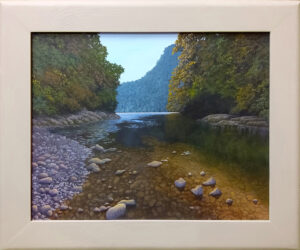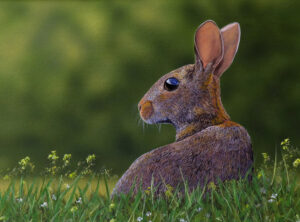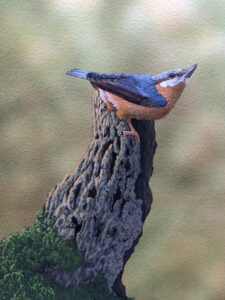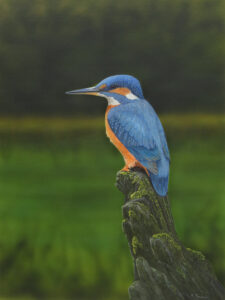For over forty years my interest in painting has continued to flourish and I have continued to experiment with various techniques and mediums. I also studied Art and Photography to advanced levels through college courses and developed skills in various media and subject matter through the wonderful classes taught by Helena Anderson from whom I learned so much, over a period of five years or more, as did many other student artists, many of whom are still painting today.
I now concentrate on oils and acrylics and occasionally use an air brush to produce out of focus backgrounds in my wildlife paintings. My style is realism, but not necessarily photo realism as I may start off using many photos to create the composition and then using photos for reference when painting detailed elements within the painting, not just copying one photo, many times deviating completely from photographs and just using my imagination. But always trying to end up with a realistic looking piece of work, as I have always been inspired by realism whether landscapes, wildlife or still life. I think my love of detail came from my occupation as a Maxillo- Facial Technician at the hospital, constructing splints for fractured jaws and facial and body prostheses for cancer patients, where detailed accuracy was paramount.
The process of a painting starts with cutting hardboard or MDF (medium density fibre board) and coating with five or six thin layers of gesso, painted on with a small foam roller to create a very fine tooth, so that the surface looks smooth to the eye but has a fine texture. This helps with the blending of either acrylics or oils and stops the paint just sliding around.
Next is the block -in, where I am roughly blocking in the colours that I can see, but looking generally for the mid-tones, this is all done in acrylics. The painting at this stage looks dull and lifeless and this is the stage you can easily give up and think it’s not working; this is the advantage of acrylics as you can press on and keep painting. I find if I’ve done the block-in in oils, I must wait for this to dry over many days, by which time I may lose interest in the painting, and I have done many times!!
Next stage is getting the colours and tones as near as I can and adding some detail and getting the painting ready for the final details and highlights to bring it all together and to create light within the picture.
Sometimes for the final stage I may switch to oils, depending on how the painting is looking. The oils allow for better blending and more realistic graduations of colour and also don’t darken on drying as acrylics do. Many times, I will complete the whole painting in acrylics but if I’m struggling to get the look I want I will switch to oils, the painting then becomes an acrylic / oil painting, if the whole painting is gone over in oils I class it as an oil painting.
- “Nuthatch” (acrylic and oil painting)
- “Waiting For A Catch” (acrylic painting)
Finally, I spray the picture with a matt solvent-based varnish that can be used for both acrylics and oils. I use matt as I hate the glare from lights that reflect in a gloss varnish, I think this preference came from my early days working in gouache, with its lovely matt finish.
Brushes I use are anything from large flats to the tiniest miniature painting brushes for the smallest details, I keep all brushes, even when worn out, quite often cutting into them to make my own specialist brushes for grasses etc. I find small flats excellent for foliage on trees by using just the corners to gently dab on different shapes.
The paint I use varies; at present I use acrylic gouache (matt acrylic) as this gives a matt finish and allows oil paint to adhere much more easily than a gloss acrylic; if using a glossier acrylic, I would use a matt medium added to the paint. I use standard oil paints with Zest-it brush cleaner and thinner to let the paint down and speed up drying (I can’t use alkyd paints or mediums such as Liquin as I am highly allergic to them). If painting more than one layer of oil, I then mix in linseed or walnut oil into the paint to create the fat over lean principle.
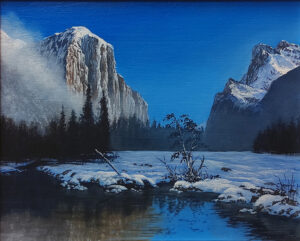 I have held a lifelong passion for walking in the countryside of England, Wales and Scotland and I endeavour to capture the varied and ever-changing lighting conditions which make the scenery in the countryside so spectacular. Mountains are particularly close to my heart, and I enjoy using the above techniques to capture their majesty, equally I like to paint the beautiful scenery provided by the Norfolk landscape where I have lived for almost 40 years. My wildlife paintings are inspired by my studies of the works of: Carl Brenders, Robert Bateman and Daniel Smith whose work may not be known in the general art world but are top world-class wildlife painters with exceptional talent.
I have held a lifelong passion for walking in the countryside of England, Wales and Scotland and I endeavour to capture the varied and ever-changing lighting conditions which make the scenery in the countryside so spectacular. Mountains are particularly close to my heart, and I enjoy using the above techniques to capture their majesty, equally I like to paint the beautiful scenery provided by the Norfolk landscape where I have lived for almost 40 years. My wildlife paintings are inspired by my studies of the works of: Carl Brenders, Robert Bateman and Daniel Smith whose work may not be known in the general art world but are top world-class wildlife painters with exceptional talent.
I am a member of the West Norfolk Artists Association, Art 21, and the Wash Group, I exhibit regularly in the Norfolk area. I also enjoy passing on my skills and knowledge to budding artists and have taught in various workshops in the use of oils, acrylic and pastel painting.
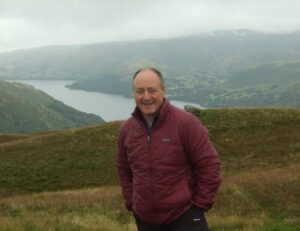 I love to paint in a realistic style and classical realism has a special interest to me with its chiaroscuro lighting effect of the old masters still life paintings, I quite often try to emulate this in my own still life works.
I love to paint in a realistic style and classical realism has a special interest to me with its chiaroscuro lighting effect of the old masters still life paintings, I quite often try to emulate this in my own still life works.
I hope this has been of some interest to the WNAA members of how I go about my painting process.
Keith Powell
